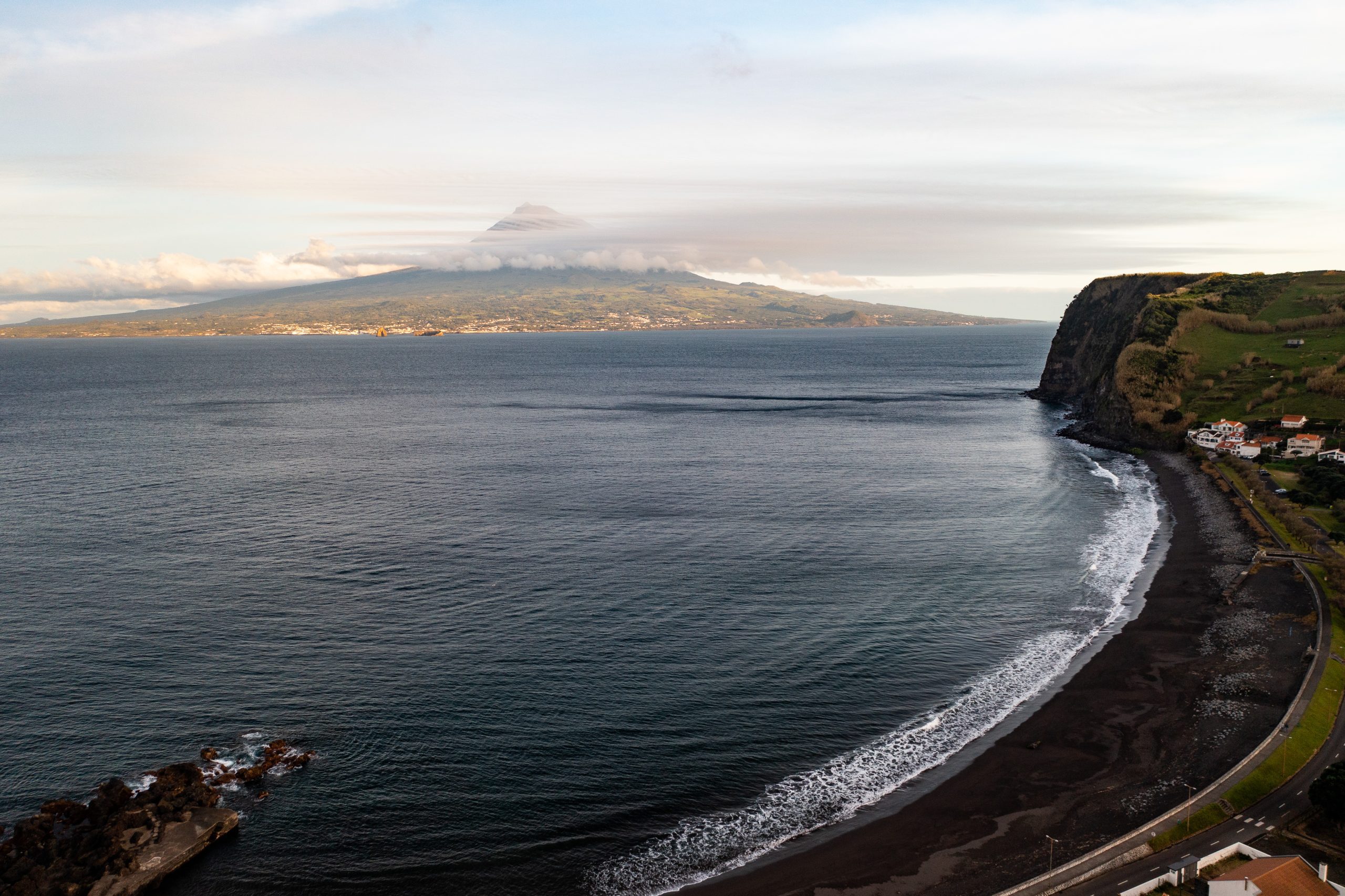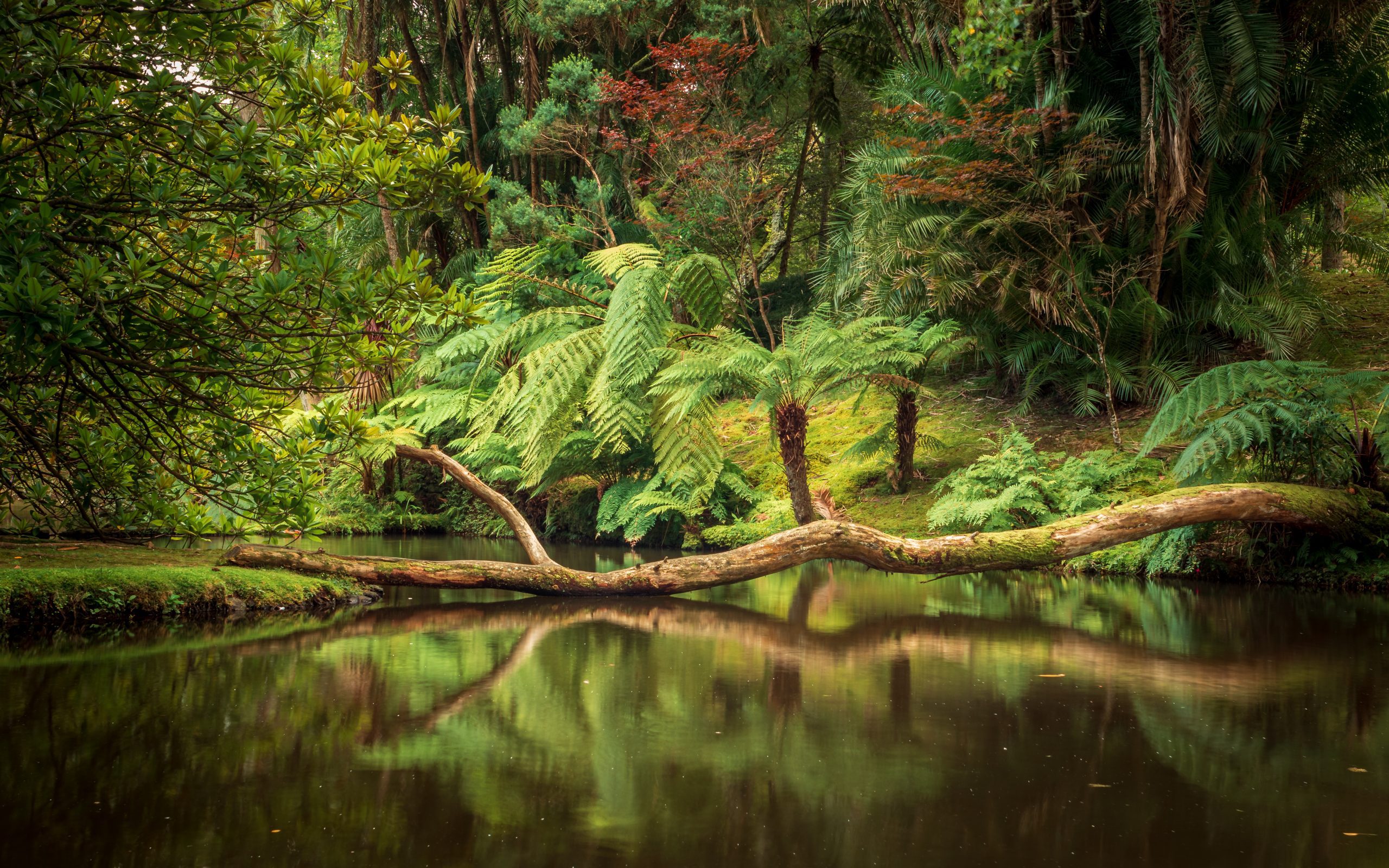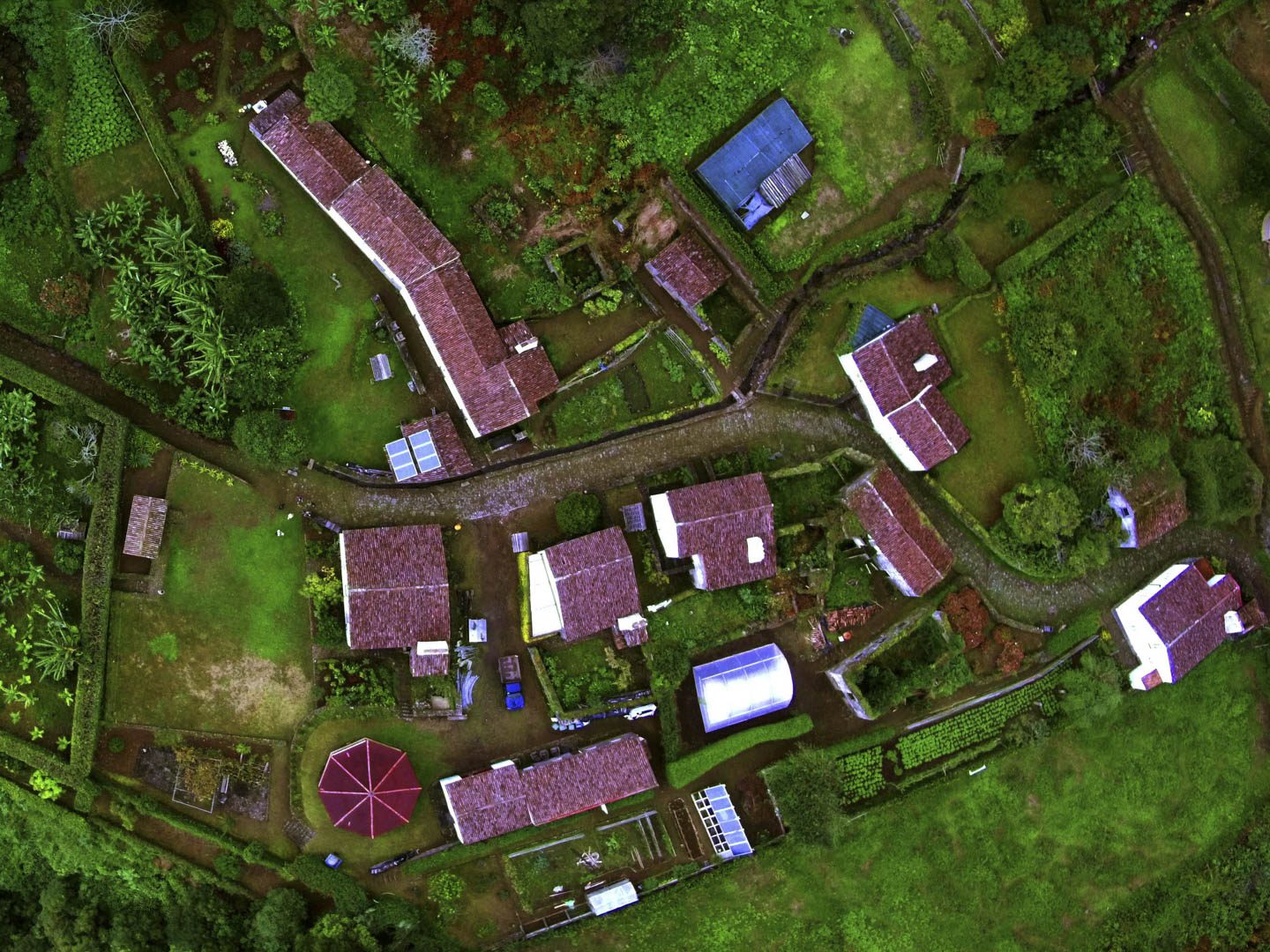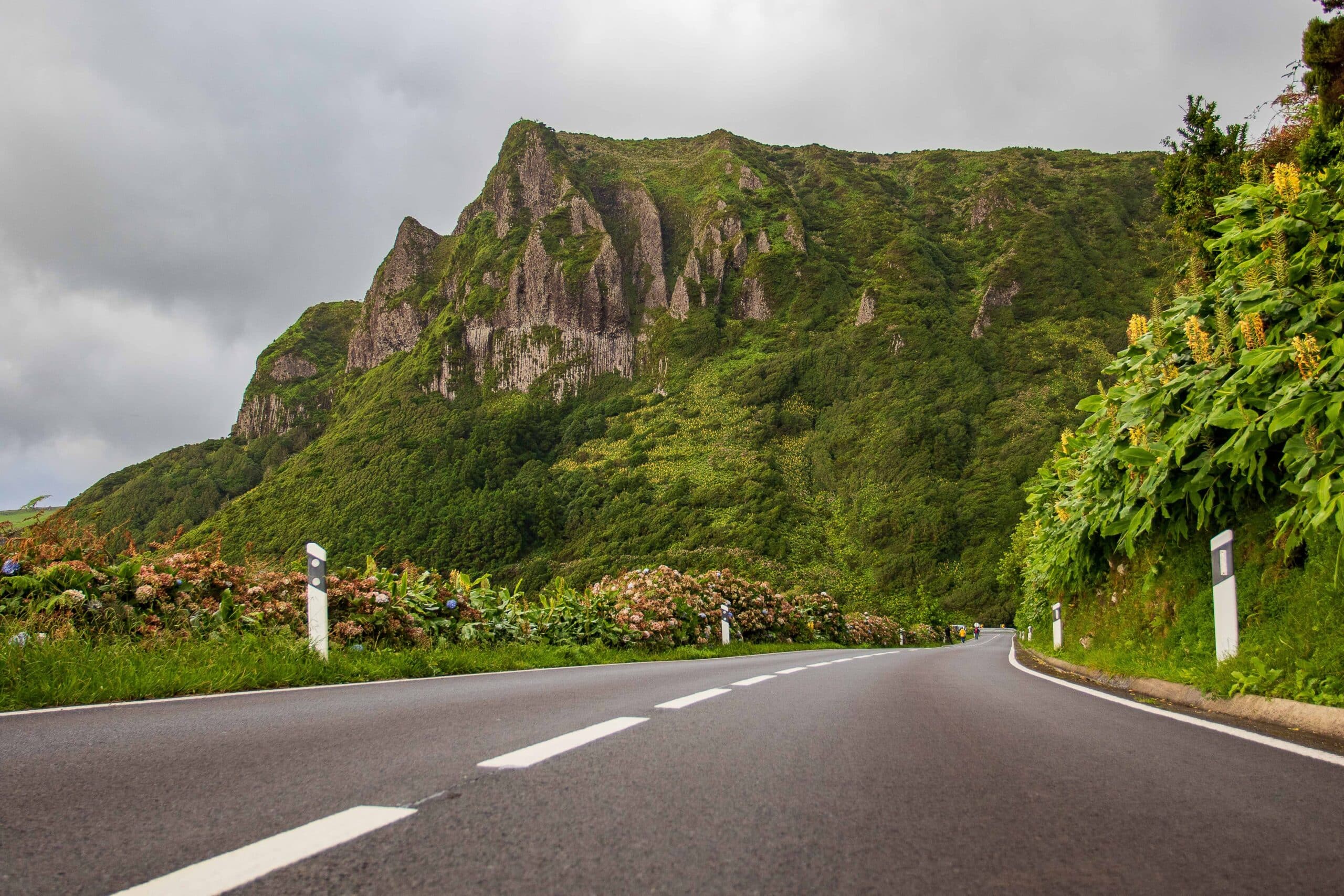The Poço do Bacalhau Waterfall is considered one of the most emblematic tourist attractions on the island of Flores. It is located in the Protected Landscape Area of the Central Zone and West Coast Cliffs and is part of the Flores Natural Park.
This magnificent waterfall is located in the parish of Fajã Grande, in Lajes das Flores, on the island of Flores. Here, you can enjoy the crystal-clear water that collects in the Poço do Bacalhau and appreciate the natural beauty of this space. This is undoubtedly one of the most beautiful waterfalls on the island.
So, to help you get to know this imposing waterfall, we’ve prepared a guide with the most relevant information about it and some tourist attractions you can’t miss during your stay on the island.
What is Poço do Bacalhau
The Poço do Bacalhau Waterfall is a majestic waterfall that plunges approximately 90 meters to form a small lake known as Poço do Bacalhau. As you might expect, this place is popular with both kids and adults, who come here to enjoy themselves.
This magnificent natural tourist attraction, often used as a bathing area, is surrounded by a magical atmosphere where the Azorean endemic vegetation is predominant — the well-known Macaronesian Laurissilva and extensive regions of moss (Sphagnum sp.).

Did you know
The Poço do Bacalhau Waterfall has been part of the UNESCO World Network of Biosphere Reserves since 2009.
It’s essential to note that, despite being a popular tourist destination, the Poço do Bacalhau waterfall is remarkably well-preserved in terms of its fauna and flora. Additionally, tourist facilities such as car parks and restaurants are located near the waterfall.
What are you waiting for to dive into this magical pool? Savor these clear, refreshing waters!
Origin of the Name “Poço do Bacalhau”
As you might expect, there are various local theories about the origin of the name of the Poço do Bacalhau waterfall. However, we believe the most plausible explanation is that, at a particular time of day with a specific solar orientation, the landscape may visually resemble a codfish steak.
What to Do in Poço do Bacalhau
Regardless of age or personal tastes, Poço do Bacalhau will fascinate anyone. Exploring this waterfall is always a suitable choice for those seeking a memorable experience surrounded by nature. From activities that appeal more to your spirit of adventure to permanent contact with nature that gives you more peaceful and relaxing experiences, the Poço do Bacalhau Waterfall has options for everyone!

Did you know
This waterfall is renowned for its extreme activities, including canyoning.
To complement your visit, we’ve curated a selection of activities and experiences that you won’t want to miss during your time there.
Take the Poço do Bacalhau Hiking Trail
To access the Poço do Bacalhau waterfall, you’ll have to walk along the Lagoas Viewpoint/Poço do Bacalhau (PR03 FLO) footpath, which will take you from the Lagoas Viewpoint to the waterfall. This linear trail is approximately 7.3 kilometers long and is considered a challenging route, with a high degree of difficulty for beginners. Additionally, it takes an average of three hours to reach your destination.
The best time to visit this trail is between March and September. Here, you will also enjoy the peace and tranquility provided by the walk, observing numerous bird species and endemic flora.
Visit Tourist Attractions Near the Poço do Bacalhau Waterfall
To complement your visit to Poço do Bacalhau, we’ve compiled a list of the ten main points of interest located within a 5-kilometer radius of this fantastic waterfall.
- Fajã Grande Parish Council (773 m) | São José Parish Church (785 m) | Church of Nossa Senhora do Carmo (1 km) | Chapel of St. Anthony of Lisbon (1 km) | Poço da Ribeira do Ferreiro (3 km) | Império do Divino Espírito Santo da Fajãzinha (3 km) | Ribeira Grande Waterfall (3 km) | Fajãzinha Parish Council (3 km) | Church of Nossa Senhora dos Remédios (3 km)| Morro do Alto viewpoint (3 km).
Planning Your Visit To Poço do Bacalhau
Best Time to Visit
Poço do Bacalhau is a tourist attraction known for its natural pools. In this sense, we believe that the best time to visit and thoroughly enjoy this attraction is during the hottest and driest seasons of the year. Spring and summer may, therefore, be the best times to visit Poço do Bacalhau. During these months, temperatures are milder, and there is less chance of rain, which makes conditions more favorable for exploring the natural pools, swimming, and enjoying the surrounding landscape.
However, it is essential to note that the climate in the Azores can be pretty variable, and there can be some rainfall even during the summer months. We therefore recommend that you:
- Check the weather conditions before planning your visit.
- Be prepared for rapid changes in the weather.
In any case, if you prefer to avoid crowds, spring and early autumn may also be suitable options, as Flores Island tends to be less crowded in the low season. However, regardless of the season, Poço do Bacalhau offers a unique experience and an opportunity to appreciate the natural beauty of the island of Flores.
Check all our articles about the weather in the Azores throughout the year 🌤️ ☔️: January | February | March | April | May | June | July | August | September | October | November | December
What to Bring
Have you planned your visit to the Poço do Bacalhau Waterfall? It’s time to discover which items we consider essential and which you can’t do without to make your experience the best it can be.
In this regard, we recommend wearing comfortable clothes and footwear suitable for the trail to your destination. You should also take a rucksack with you:
- Extra warm clothing;
- Swimsuit — in case you want to dive into the waterfall.
- A beach towel for cleaning yourself or sitting on the ground.
- Waterproof or windbreaker.
- Camera to eternalize moments.
- Sun cream.
- Some snacks.
- Water.
Note: When visiting Poço do Bacalhau, please respect the environment and follow the local rules to preserve the unique beauty of this natural area.
How to Get to Poço do Bacalhau
Setting off from Lajes das Flores in the direction of the parish of Fajã Grande, you’ll have to travel around 18.5 kilometers to reach the imposing Poço do Bacalhau waterfall. You have several options for getting to your destination: you can choose to travel by car/motorbike, taxi, public transport (bus), or bicycle.
Following the ER1-2, the journey takes approximately:
- Car, motorbike, or taxi: 25 minutes;
- Bus: 55 minutes — although the bus journey only takes 42 minutes, you should allow an extra 15 minutes for walking. In other words, this journey takes a total of 1 hour and 10 minutes.
Alternatively, you can cycle along the Galo Municipal Road, although it will take you (on average) 1 hour and 30 minutes to reach your destination.
Planning a trip to the Azores? These articles will help you: How to Get to the Azores 🗺️ | Azores airports 🛬 | Flights between islands ✈️ | Ferries between islands ⛴️ | Which island to choose? 🏝️ | What airlines fly to the Azores? 🛩️
Where to Eat
If you need somewhere to eat near Poço do Bacalhau, click here. In this link, you’ll find the 10 best restaurants on TripAdvisor.
Where to Stay
To make your life easier, we’ve filtered the search by:
Nearby Attractions
Lajes das Flores

Lajes das Flores, based in the town of Lajes das Flores, is located on the south coast of the island of Flores. It is part of the Western Group of the Azorean archipelago and is the westernmost in Europe.
Founded in 1515, the municipality is divided into seven parishes: Fajã Grande, Fajãzinha, Fazenda, Lajedo, Lajes das Flores, Lomba, and Mosteiros.
Here, the locals seem to live in perfect balance with nature. Breathtaking landscapes surround every nook and cranny, offering an extensive natural and built heritage that deserves a visit. With this in mind, we’ve decided to highlight some of the main tourist attractions in this region:
- Lajes das Flores Pier Battery | Church of Nossa Senhora do Rosário | Fort of St. Anthony of Lajes das Flores | Lajes das Flores Harbor | Sete Lagoas | Lagoa da Lomba | Rocha dos Bordões | Rocha dos Frades | Fajã de Lopo Vaz | Craveiro Lopes Viewpoint | Lajedo Viewpoint | Fajã do Conde Viewpoint | Ponta Negra Lookout Viewpoint | Gruta do Galo | Enxaréus Cave | Monchique Islet | Alagoa Bay
Rocha dos Bordões
Rocha dos Bordões forms a geological feature with large vertical prismatic basalt columns, reaching 20 meters high, resembling Bordões. The Regional Government of the Azores has classified this tourist attraction as a Regional Natural Monument since 2004.

Did you know
Rocha dos Bordões is approximately 570,000 years old and is located in Cabo Baixo das Casas, in the parish of Mosteiros, in the municipality of Lajes das Flores, approximately 10 kilometers from the Poço do Bacalhau waterfall.
This fantastic rocky monument is part of the Special Conservation Area of the Central Zone — Morro Alto, within the Natura 2000 Network, and is a geosite of the Azores Geopark — UNESCO World Geopark.
In addition, this Natural Monument is home to species of flora and fauna endemic to the Azores. These features, together with its geological features, make it an ex-libris of the island and a popular observation point for nature photography lovers.
Fajã de Lopo Vaz

Fajã de Lopo Vaz is located in the municipality of Lajes das Flores, approximately 15 kilometers from the Poço do Bacalhau waterfall. This fajã was most probably the first inhabited place on the island of Flores. The name “Lopo Vaz” comes from one of its first settlers.
At one time, the inhabitants of Fajã de Lopo Vaz were self-sufficient due to the difficulties of access by land. Today, thanks to the difficult access, the fajã is practically uninhabited. However, pastures and banana plantations cover this area, making it a popular spot for ornithological observation, Macaronesian studies, and the appreciation of deserted beaches.
It is also one of the few places on the island where wild goats can be found. If you want to embark on an adventure and discover this rural paradise, you can follow the Fajã de Lopo Vaz Trail (PRC04 FLO), a circular route 3.4 kilometers long.
Check all our articles about each one of the most relevant points of interest on Flores Island: Poço do Bacalhau | Rocha dos Bordões
Complementary Information
Best Season to Visit the Azores
The Azores Archipelago boasts a unique climate that shapes its lush landscapes, making it a splendid year-round destination. With mild temperatures and minimal fluctuations, each season offers something unique. Spring averages 16 °C, summer reaches 21 °C, autumn cools to 18 °C, and winter remains mild at 14 °C.
→ For a detailed breakdown of the weather by month, check the following links 🌤️☔️: January | February | March | April | May | June | July | August | September | October | November | December
How to Get to the Azores
The Azorean Archipelago is easily accessible through numerous flight routes. Lisbon and Porto are the main entry points to the continent, with direct flights available to São Miguel (PDL), Terceira (TER), Faial (HOR), Pico (PIX), and Santa Maria (SMA). To find the best flight, use search engines like eDreams or Skyscanner. These platforms let you compare prices and schedules from multiple airlines in one convenient location.
For more details on how to get to the Azores, take a look at our complete guide. But what if you want to explore beyond your arrival island? We’ve got you covered!
- Azores airports 🛬
- Flights between islands ✈️
- Ferries between islands ⛴️
- Which island to choose? 🏝️
- What airlines fly to the Azores? 🛩️
→ Once you’ve found the perfect route, book your tickets and get ready to experience one of the world’s most stunning island groups!
Travel Essentials
Essential Information for your Azores trip: Azorean Language & Phrases 🗣️ | Currency & Banks 💵 | Credit Cards & Traveler’s Cheques 🏧 | Driving in the Azores 🚗 | Electricity 🔌 | Experiences & Tours 🗺️ | Health & Safety 🩺 | Internet & Wi-Fi Access 🛜 | Phones & Mobile Service 📞 | Post Offices & Buying Stamps ✉️ | Public Holidays 🏖️ | Shopping 🛒 | Time & Daylight 🕒 | Whale Watching Guide 🐳 | Best Island to Visit 🏞️
Useful Tools & Apps
The weather in the Azores can be variable, so it’s helpful to use some apps before visiting the islands. Spotazores provides live camera feeds from the main tourist attractions, allowing you to check the weather and plan your visit. For accurate weather predictions, use Windy or Windguru — they provide the most reliable predictions.
Video
Conclusion
Surrounded by paradisiacal scenery, the Poço do Bacalhau Waterfall is a beautiful waterfall that fascinates all who visit it. It is, therefore, considered a must-see for anyone visiting the stunning island of Flores. Set in the immense Flores Natural Park, beautiful natural surroundings surround Poço do Bacalhau.
Here, you can give free rein to your more adventurous spirit and enjoy real moments of leisure with your family and friends. We also suggest that you set off to discover the beautiful municipality of Lajes das Flores, where you can enjoy the region’s vast natural, cultural, and gastronomic heritage.
What are you waiting for? Book your visit to the Poço do Bacalhau Waterfall now to discover this and many other iconic tourist attractions on the island!
Authors’ Note
I am pleased to inform you that all the recommendations in this article are based on my personal experience and observations. As the author, I have personally visited each attraction mentioned, ensuring that every suggestion is grounded in first-hand knowledge and genuine enthusiasm.
FAQs
Poço do Bacalhau is located in the parish of Fajã Grande, in the municipality of Lajes das Flores, on Flores Island, Azores.
The waterfall has a drop of approximately 90 meters, making it a striking natural feature.
Yes, you can swim in the lagoon formed by the waterfall, which is a popular bathing spot.
The best times to visit are spring and summer when the weather is warmer and there’s less chance of rain.




















